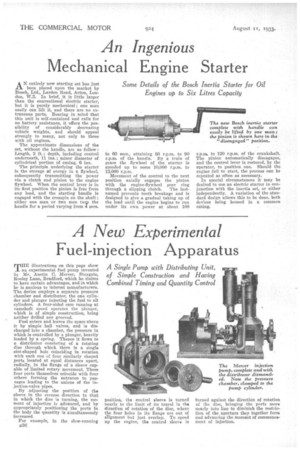An Ingenious Mechanical Engine Starter
Page 46

If you've noticed an error in this article please click here to report it so we can fix it.
AN entirely new starting set has just been placed upon the market by Bosch, Ltd., Larclen Road, Acton, London, W.3. In brief, it is little larger than the conventional electric starter, but it is purely mechanical; one man easily can lift it, and there are no extraneous parts. Bearing in mind that this unit is self-contained and calls for no battery assistance, it offers the possibility of considerably decreasing vehicle weights, and should appeal strongly to many, not only to those with oil engines.
The approximate dimensions of the set, without the handle, are as follow: Length, 2 ft.; depth, including control underneath, II ins.; minor diameter of cylindrical portion of casing, 6 ins._ The principle underlying the starter is the storage oZ energy in a flywheel, subsequently transmitting the power via a clutch and pinion to the engine flywheel, When the control lever is in its first position the pinion is free from any load, and the starting handle is engaged with the crosspin on the shaft ; either one man or two men turp the handle for a period varying from 4 secs. to 60 sees., attaining 80 r.p.m. to 90 r.p.m. of the handle. By a train of gears the flywheel of the starter is speeded up to some 10,000 r.p.m. to 12,000 r.p.m.
Movement of the control to the next position axially engages the pinion with the engine-flywheel gear ring
through a slipping clutch. The lastnamed prevents tooth breakage and is designed to give a gradual taking up of the load until the engine begins to run under its own power at about 100 r.p.m. to 120 r.p.m. of the crankshaft. The pinion automatically disengages, and the control lever is restored, by the operator, to position one. Should the engine fail to start, the process can be repeated as often as necessary.
In special circumstances it may be desired to use an electric starter in conjunction with the inertia set, or either independently. A variation of the standard design allows this to be done, both devices being housed in a common casing.




















































































